Students hit on great ideas in a hurry at pitch off finale
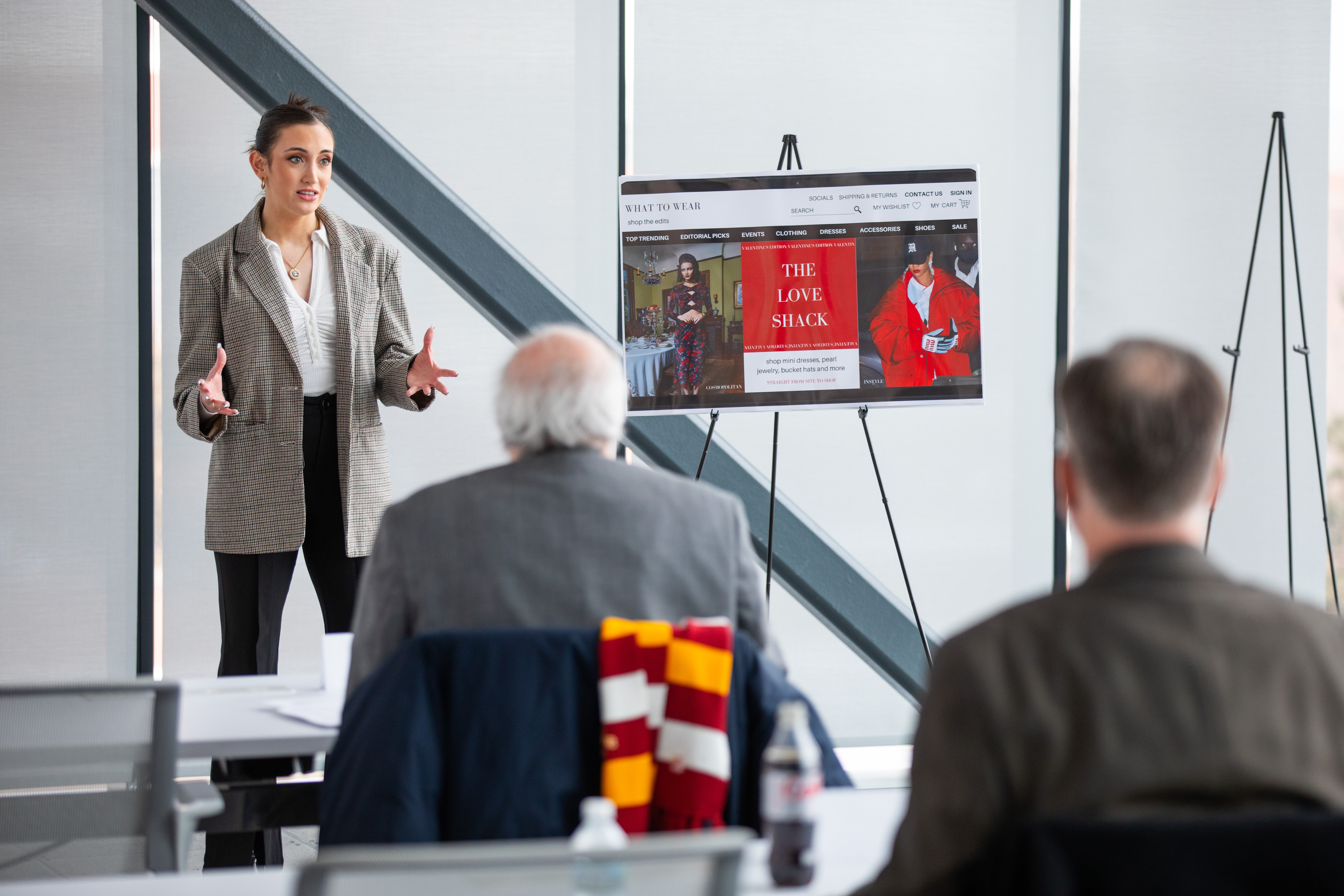
Alyssa Brascia, senior in apparel, merchandising and design, presents at the college-by-college pitch off finale Feb. 22. She won the overall first prize for best new idea for her concept of What to Wear, a website that tracks clothing featured in fashion magazines and offers links to purchase the items. Photos by Christopher Gannon.
The fifth annual college-by-college pitch off wrapped up this week with the campuswide finale, capping off two weeks of students stepping up to make the case for their innovative ideas.
The pitch off series begins locally, as students compete against fellow classmates in their college for first- and second-place prizes of $250 or $500 in one of two categories: new idea or existing business idea, for plans that have already moved past the concept stage. They get 90 seconds to make their pitch, with two minutes allowed for follow-up questions by the judges.
Nearly 100 students gave it a shot this year. Here's a college-level breakdown of participation:
- Business (25, the maximum allowed)
- Engineering (22)
- Liberal Arts and Sciences (15)
- Design (12)
- Human Sciences (10)
- Agriculture and Life Sciences (7)
- Veterinary Medicine (5)
Four prizewinners from each college faced off in the Feb. 22 finale at the Student Innovation Center, with the winners in each category taking home $5,000. Second-place finishers received $2,500 awards, and prizes of $1,000 to $2,000 were given at the discretion of the judges: Ivy College of Business dean and interim vice president for economic development and industry relations David Spalding, former Workiva senior vice president and current venture capital investor Dave Tucker, ISU Startup Factory director Peter Hong and Iowa Small Business Development Center director Lisa Shimkat.
The overall winner for best existing business idea was Jassma'ray Johnson, a senior in psychology who founded Simply Samone, an affordable lip gloss line that focuses on Black women and uses organic, vegan and cruelty-free products.
The best new idea winner was Alyssa Brascia, a senior in apparel, merchandising and design who proposed a website called What to Wear that offers affiliate links to clothing items promoted in fashion magazines.
Other pitch off prize winners included:
New ideas
- Charles Yang, second place
- Jessica Meseck, third place
- Chloe Grote, honorable mention
- Joel Houge, honorable mention
Existing business ideas
- Tyler Heintz, second place
- Miranda Keith, third place
- Brynn Sweere, best presentation
- Arilyn Tegtmeier-Oatman, honorable mention
- Justin Kirschner, honorable mention
- Sam Blythe, honorable mention
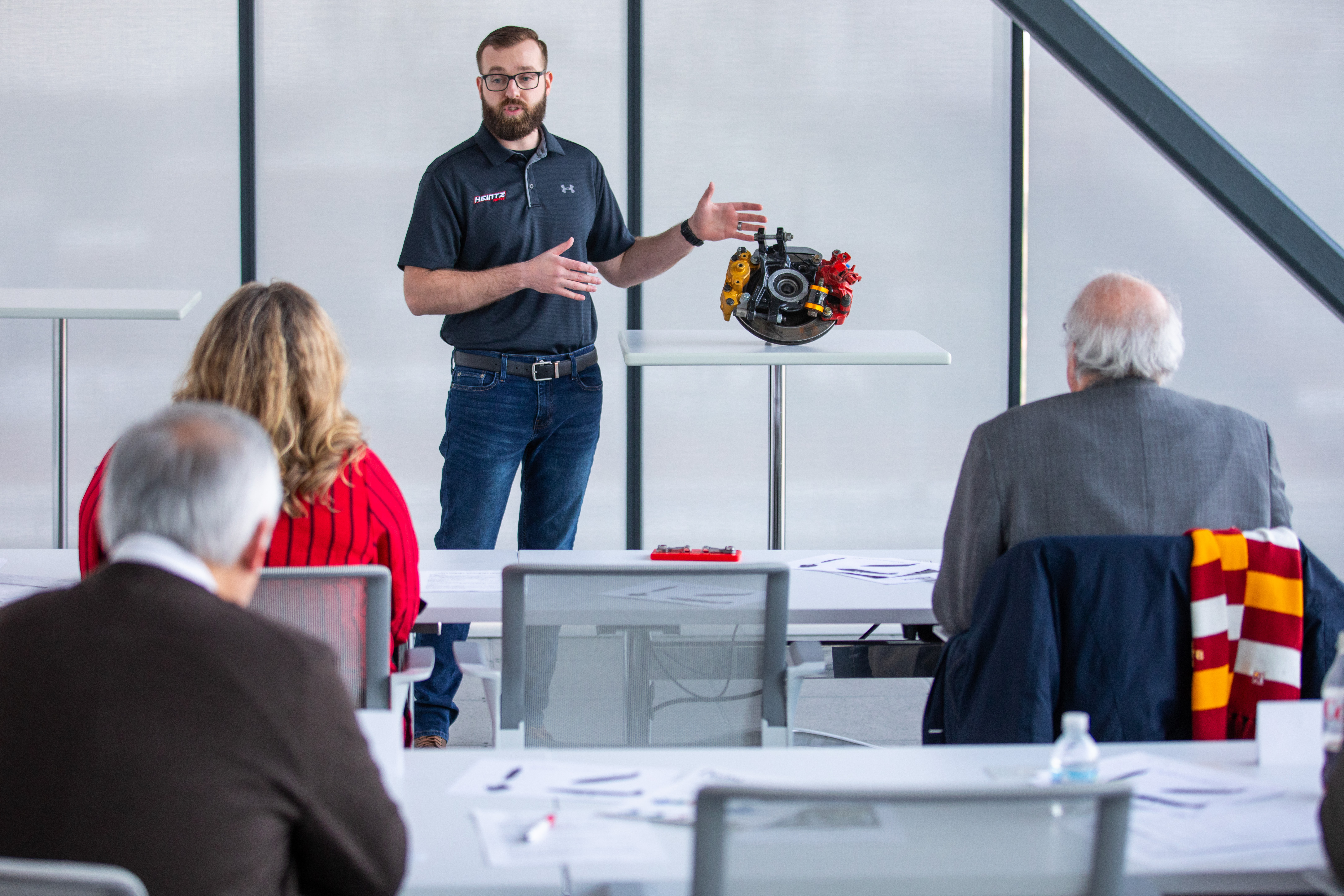
Tyler Heintz, a senior in mechanical engineering, presents his idea for a specialized brake system for drift racing cars. He won second place in the existing business idea category.
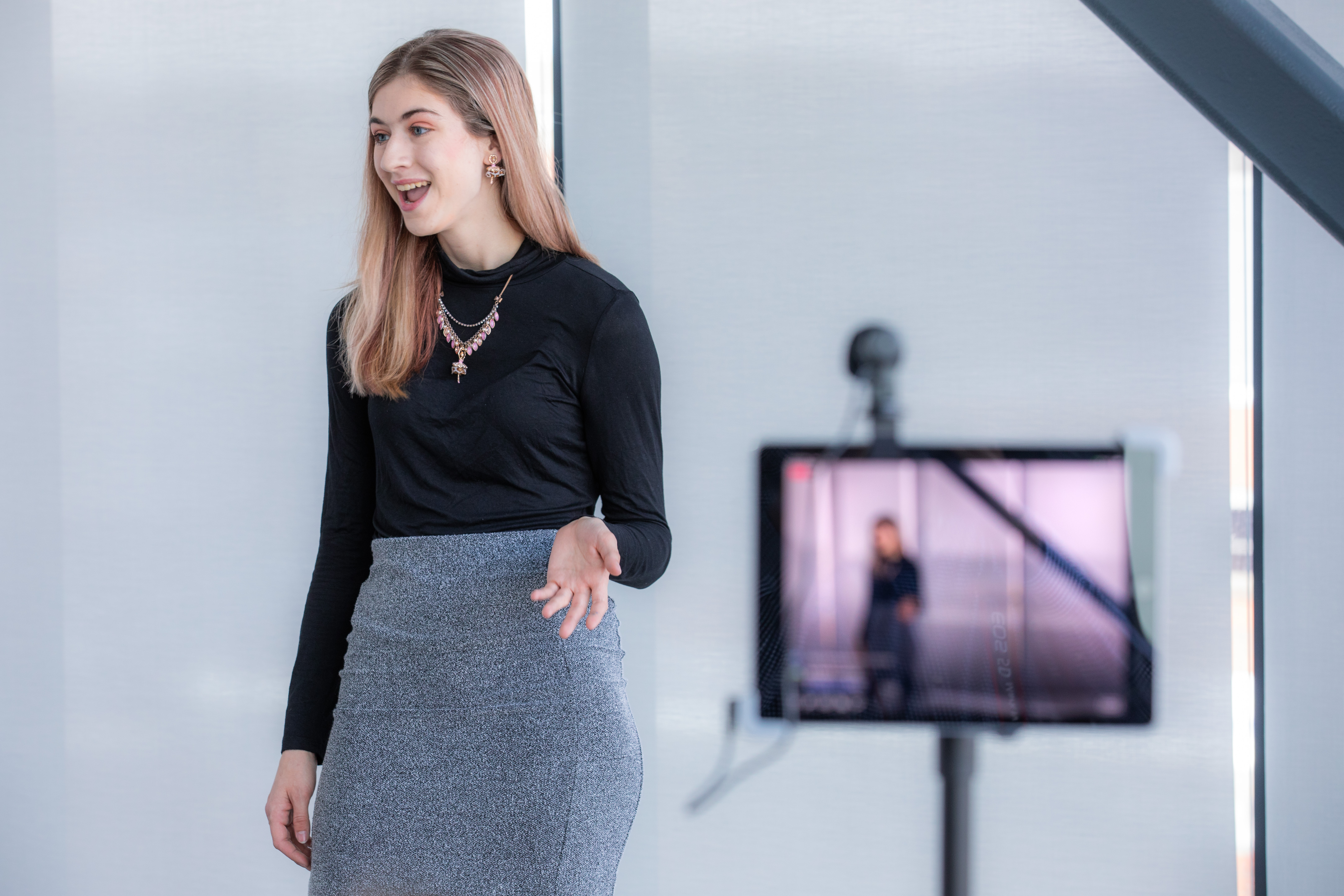
Madeline Ladehoff, a junior in entrepreneurship, talks about her idea for a dance studio with an attached gym for parents who have dropped off their children for dance lessons. A screen in the background shows the video feed of the presentation at the college-by-college pitch off finale, which was livestreamed on Facebook.

Azeez Idris, a gradaute student in computer science, pitches judges on his idea for a digital campaign to encourage people to share stories about their biggest failures.
LAS announces effort to reimagine programs, begin budget reduction
The College of Liberal Arts and Sciences (LAS) will embark on a multiyear "Reimagining LAS" initiative to right-size its budget in response to changing enrollment and student demand and to position the college for future success. The initiative was announced to LAS department chairs Feb. 23.
LAS began the current fiscal year with an annual budget deficit of $11.4 million, relative to a $105 million operating budget, which is expected to grow to an annual deficit of $15 million by FY2025.
According to LAS dean Beate Schmittmann, the college's financial position has faced many headwinds in recent years, related not only to enrollment levels, but also to absorbing rising costs and other trends. For example, the demand for courses that satisfy general education requirements has decreased over the last decade, as most students now arrive on campus having already earned a significant number of college credits in high school.
"Rather than managing shortfalls from year to year, we need to think strategically about our students and their needs, and chart our path toward a sustainable future," Schmittmann said. "The key to success is delivering our core major and foundational courses in a thoughtful and efficient manner, and recruiting and retaining students by offering the right mix of programs and well-designed curricula."
In addition to general education requirements, LAS teaches the majority of foundational courses required by non-LAS majors, including advanced math, chemistry, physics and biology.
Multiple actions to manage reductions
The college will work with chairs and departments to develop plans for meeting budget targets, which differ by academic department and are based on trends such as the number of undergraduate majors, student credit hours taught by departments and research productivity. Specific cost-cutting measures will be developed by individual departments, supported by planning tools developed by the college, and may include:
- Streamlining course offerings
- Phasing out low-enrollment programs
- Merging departments or programs following established university policies and procedures
LAS will redirect unrestricted resources and make reductions in its central budget. To minimize the overall impact of reductions, the college has received additional financial support from the office of the senior vice president and provost, in recognition of the central role LAS plays in fulfilling the teaching and research missions of ISU and creating a rich student experience.
Investing in the future
LAS will continue to make targeted investments in programs and initiatives that address student and employer demands. Recent examples include work on a new bachelor's degree in climate science and the launch of a master's degree program in artificial intelligence. A recent gift to the college will be deployed to spur entrepreneurial and innovative approaches towards redesigning curricula and creating new programs in response to student interests.
Despite the challenges, Schmittmann is confident in the college's ability to serve students, employers and the state of Iowa, and reimagine itself in higher education's ever-changing landscape.
"We will deliver high-quality academic programs, conduct nationally recognized research, identify and respond to opportunities, and continue making a difference in the community," she said. "This isn't just about reductions. This is an opportunity to create a strategic, focused path forward that will position LAS well for the next decade."
Regents approve adjustment to P&S pay matrix
A 6% adjustment to the pay matrix for professional and scientific (P&S) employees received approval from the state Board of Regents Wednesday and takes effect March 1. University human resources (UHR) leaders worked with consultants this winter to tweak the pay matrix to better align it with changes occurring in the market. It's the first overall adjustment to the pay matrix since it was adopted in September 2020.
Adjustments for two pay grades in the matrix, P803 and 804, took effect Dec. 1 as part of a strategy to be more competitive in the local Ames market.
Adjusting the compensation structure doesn't automatically move any employee's salary, but rather increases P&S employees' earning potential in the years ahead. However, the change will impact about 200 P&S employees whose current pay either places them below the new minimum or back within the new maximum of their pay grades. UHR vice president Kristi Darr said the managers of these employees will receive letters next week to share with their impacted employees.
Darr said an estimated 179 employees fall into the first category, and by Oct. 1 their salaries must be raised to at least the new minimum. She said units should plan for these required adjustments and, when possible, make the adjustments before the deadline.
Another 24 P&S employees return within their pay range with the matrix shift. This makes them eligible again for a performance-based increase to their base salaries. Employees earning the maximum in their pay grade can only receive one-time payments as part of the annual performance increase process.
The starting salaries for new P&S employees on or after March 1 also must meet at least the new minimums.
Darr said UHR's intent is to separate pay matrix adjustments from the annual performance-based increase process to give units time to plan for the financial impact of matrix changes and, where possible, the flexibility to adjust compensation to the market ahead of the performance review cycle.
Job assignments in pay grades also being studied
Darr said a second phase of their review of the P&S compensation structure, evaluating the pay grades some job profiles were assigned to, should conclude later this spring. Some employees could see their pay grade move higher as a result of the review.
"This step is an important piece in ensuring the overall structure remains competitive," Darr noted.
She emphasized this is a review of jobs, not individual employees. The review doesn't include and will not change job duties or exemption status under the federal Fair Labor Standards Act (FLSA). Similar to the pay matrix adjustment, by Oct. 1, units would need to meet at least new pay grade minimums for any employees whose job profile moves to a higher pay grade.
In-person again, 25 Year Club to honor 110 faculty and staff
Resuming its annual in-person banquet to honor members reaching notable anniversaries, the 25 Year Club will gather next week to celebrate 110 Iowa State faculty and staff -- a group that represents a combined 3,260 years of university service.
The 25 Year Club was formally founded in 1934 by Col. Harold Pride, the first director of the Memorial Union, to honor employees who had worked at Iowa State for 25 continuous years or more. Over its long history, which informally stretches back to 1915, more than 3,400 faculty and staff have become members of the club, which also recognizes employees when they reach 35, 45 and 50 consecutive years of working at Iowa State.
This year's honorees include 68 first-time club members who hit 25 years of service in 2021, as well as 34 with 35 years, six with 45 years and two with 50 years.
Club president Rob Wallace, associate professor of ecology, evolution and organismal biology, said holding the banquet will be a welcome return to tradition after last year's banquet was canceled due to pandemic precautions. Instead of the banquet, those honored last year received a voucher for a free meal at a local restaurant.
While the 2021 approach was appreciated and appropriate given the circumstances, it wasn't the same as meeting face-to-face, Wallace said. The banquet is free for honorees and open to all club members, an opportunity to connect with a wide variety of colleagues.
"There are a lot of us who know one another. You get to catch up with people you don't see very often, especially now," he said.
No matter their role on campus, long-serving employees are essential to Iowa State, Wallace said. While change is constant and necessary on a university campus, the institution also is steeped in history. Faculty and staff with decades of experience help navigate that balance between old and new, making the long view clearer, he said.
"Those individuals are particularly valuable. They hold a lot of institutional knowledge that's difficult to write down," he said. "That smooths out the curve of the cycles of change we go through at the university."
A list of this year's honorees is online, as is a collection of some of their milestones and memories. The personal reflections provide some insight into the career high points of devoted employees and make for great conversation starters at the banquet, Wallace said.
The Feb. 28 banquet at the Scheman Building begins with a social hour at 5 p.m. and music from Indigo Monks, a jazz group that features some ISU faculty. Dinner begins at 6:15 p.m., followed by remarks by and photos with President Wendy Wintersteen, who was honored for her 35 years of service at the 2015 banquet.
There's still time to share comments on the strategic plan draft
Five aspirational statements that would drive the university's strategic planning over the next nine years are being shared this month and next with various campus audiences and external stakeholders. The five "to be" statements are:
- To be the most student-centric major research university.
- To be the university that fosters lifelong learning.
- To be the trusted partner for proactive and innovative solutions.
- To be the university that creates opportunities and forges new frontiers.
- To be the university that cultivates a diverse, equitable and inclusive environment where students, faculty and staff flourish.
In town halls for faculty-staff and student audiences, vice president for research Peter Dorhout, who chairs the strategic plan steering committee, outlined a yearly review, priority-setting and project proposal process designed to propel the university forward while ensuring some flexibility with changing conditions. The strategic plan really is a strategic process, he said.
Learn more
"We were asked to create an innovative plan, one that's dynamic," he said. "This proposal includes a built-in process to get campus input and feedback on how we're doing and to take advantage of opportunities when they come up.
"It's a unique process that requires retooling, repositioning and continuous input to capture those opportunities," he added.
Dorhout outlined an approximately 15-month recurring process that would include:
- Input on progress and needs from the university community and other stakeholders
- Priorities set by senior leaders
- A request for proposals and proposal review process
- Approval of projects and budgetary commitment by July 1 each year
- Ongoing, transparent communication about the process, selected projects and outcomes
Projects could be short-term (a year or less) or require several years "to bear fruit," he said, but would contain metrics for success and completion.
The 52 members of the strategic plan working groups currently are designing the details of the new process. Project funding will require partnerships across Iowa State's four divisions, Dorhout said. It's a key consideration for the task forces to flesh out.
Thematic pillars for guidance
In addition to the five "to-be" goal statements, the working groups identified four thematic pillars that provide structure and direction to the strategic planning process: Innovative solutions, knowledge and discovery, education experience and community engagement. They complement and intersect with Iowa State's teaching, research, service and extension missions, but better describe the university's work and its audiences, Dorhout said.
Structures needed
The annual self-assessment and project proposal process adds work to already taxed university employees, Dorhout noted. He said the steering committee is "grappling with" how to manage a potentially high volume of ideas and workflow versus a desire for the most efficient, sustainable oversight structure possible. The current strategic plan draft proposes:
- A new office of strategic success to coordinate workload
- A request for proposals process
- Employee review teams (three-year terms) that assess project proposals and make recommendations to senior leaders
- A new website that shares annual process, funded projects and success stories
Next steps for the draft
Faculty, staff, students and external stakeholders are invited to provide input on the strategic plan draft in an online Qualtrics form. The form includes a link to the slides used in the town hall presentation. The Feb. 21 town hall for faculty and staff is archived on the 2022-31 strategic plan homepage, although it doesn't offer a feedback opportunity.
Listening sessions -- roughly 20 in all -- will continue through spring break, after which the working groups and consultants will modify the draft as needed and present a final draft to the steering committee by the end of March. It could land on President Wendy Wintersteen's desk in early April, and if it has her approval, it would be submitted to the state Board of Regents for final approval, possibly at its June 2 meeting. The goal is a July 1 implementation.
Twenty-four hours to lift up Iowa State

ISU Foundation staff are hopeful Cyclones around the world participate in -- and have great fun with -- the first Forever True Day, a 24-hour giving blitz scheduled from noon March 1 to noon March 2. The emphasis is on participation, with a special invitation to first-time donors.
Donors can choose from among hundreds of funds supporting the priorities of Iowa State's colleges, departments and other units, and give to what matters most to them.
Find your fund
Many of the funds are student-centric: programming, health and wellness, additional aid or scholarships, for example. Facilities and faculty recognition also are common themes.
"We're really asking the Cyclone community to come together and support the areas at Iowa State they're passionate about," said Dana Savagian, associate director for annual and special gifts. "The intent is to celebrate the university on this day.
"We're encouraging gifts at any level; the purpose is to join together and lift up Iowa State," she added.
Forever True day primarily is an online event, with a special website highlighting the many funds and campus units actively promoting their priorities on their social media platforms. Savagian said the event will include matches and challenges throughout the 24 hours to amplify the impact of every gift.
"We hope this is a really fun day for everyone," she said. The intent is to make it an annual event.
For those who can't wait, Savagian said it's possible to give to Forever True Day in advance.
Follow the progress of Forever True Day on social media:
Canvas making switch to New Quizzes
Quizzes administered through Canvas are changing, impacting every instructor and student who uses the learning management system. But for instructors who are already busy, don't worry. There is time to get used to the change.
Canvas is phasing out Classic Quizzes and replacing it with New Quizzes.
"New Quizzes give instructors more options for question types and are built for accessibility," said Lori Mickle, Center For Excellence in Learning and Teaching (CELT) instructional technology specialist.
New features include the ability to print quizzes and quiz keys, and accommodate students who need time extensions. Instructors also can create new question types that provide a variety of engaging and user-friendly assessments.
New Quizzes will be tentatively enabled in all Canvas courses campuswide on June 1.
"Starting June 1, it is up to the instructor whether they want to implement New Quizzes or continue with Classic Quizzes," said Lesya Hassall, CELT instructional technology specialist. "CELT recommends all new courses and small- and medium-sized courses that use uncomplicated low-stakes assessments consider implementing New Quizzes."
Instructors can create quizzes in the classic format until June 1, 2023. After that, Classic Quizzes can only be edited and administered to students. Canvas will sunset Classic Quizzes on June 30, 2024, but instructors can continue migrating them to the New Quizzes format after that.
The pilot
A pilot group of nine instructors are testing New Quizzes this semester. They were chosen based on their comfort level with the technology and the way they integrate quizzes into their current course content.
CELT provided training on New Quizzes for the instructors, and staff at each college have access to the new assessment tool to actively help the piloting courses, instructors and students.
Because the transition to New Quizzes is mandated by Canvas, CELT is collaborating with other peer institutions to share best practices and offer troubleshooting advice.
"It allows us to keep an open conversation to see what is working best for supporting faculty in this transition," said Gretchen Anderson, CELT instructional technology specialist. "Canvas is listening to us and activley provides updates in the development process."
Testing
Veterinary clinical sciences associate professor Jessica Ward is using New Quizzes in an elective cardiology course for third-year students.
Ward built quizzes in the new program in the same amount of time it previously took. She likes using item banks that allow questions to be stored and used in other quizzes across multiple Canvas courses, a time-saving feature.
"It is not all that different from Classic Quizzes," Ward said. "It didn't take any longer and maybe a little quicker to build. People who are not building new quizzes daily are probably not going to notice a huge difference."
Bruce Kraft is a professor of practice in the Ivy College of Business teaching a pair of courses that use New Quizzes for all exams.
"I enjoy testing new technology early, and it allows me to see if there is a way to improve exam delivery for the student," he said. "From a student standpoint, I hope they won't see a drastic change."
Both instructors said the addition of a stimulus question type is one of the most beneficial features. It allows a group of questions to be asked around a single piece of content, such as an image, video or document. The stimulus is displayed on the left side with associated questions on the right.
"In Classic Quizzes I would have had to have the image uploaded for each of my questions or the image and then all the questions after it," Ward said.
"The transition allows instructors to reevaluate their quizzes and better align them with their course learning objectives," Hassall said.
​​Canvas continues to update New Quizzes and add functionalities. For more information, go to the New Quizzes webpage.
Regents updated on free speech survey, training
At their Feb. 23 meeting, members of the state Board of Regents received updates on a November survey and current training requirement for all regent employees and students on free speech and the First Amendment.
The survey was conducted Nov. 9-Dec. 1, 2021. Iowa State achieved an employee response rate of 47.5%, and a student response rate of 10.3%, the highest among the three schools for both audiences. The results shared Wednesday were a composite of the three universities, and board chief academic officer Rachel Boon said she will share each university's data file with its institutional research office for local analysis.
Across the three universities (including a large hospital staff at the University of Iowa), nearly 29,000 employees and nearly 69,500 students received an email invitation to complete the survey. The overall response rates were 38.2% for employees and 10.2% for students. A few highlights:
- 78% of student respondents said they feel comfortable expressing their opinions in their classrooms. Fewer expressed the same comfort about expressing their opinions off campus (68%) or on social media (60%).
- 64% of employee respondents said they feel comfortable expressing their opinions both at work and off campus; just 44% expressed the same level of comfort on social media.
- 90% of student respondents believe they are good at listening to, or seeking views different from, their own. They perceive less willingness in others on campus: 41% of other students, 61% of staff and administrators and 66% of faculty will listen well to others, students responded.
- 69% of employee respondents agree their university provides an environment for open expression of ideas, opinions and beliefs, and 64% agree it does not restrict free speech. However, only 49% of respondents said they feel the environment allows them to say things they believe, and 56% said the environment allows others to say what they believe.
Board counsel Aimee Claeys provided a progress report on the universities' participation in the board-mandated free speech training, developed in tandem with the survey. All employees and students were alerted to the new training Feb. 2 and have until May 13 to complete it.
Free speech training: Completion rates as of 2-18-22
|
University |
Students |
Faculty and staff |
|
Iowa State |
13% |
50% |
|
Northern Iowa |
19% |
36% |
|
Iowa |
20% |
17% |
Parking rates
The board had its first review of proposed parking permit and student housing and dining rates for the fiscal year that begins July 1. Votes on the proposals will come at the April meeting.
The parking division is proposing to raise parking permits about 4% on July 1. The hourly rate ($1.25) at parking meters or metered lots would not change.
ISU lot permits
|
Permit type |
Proposed |
Current |
|
Reserved |
$605 |
$582 |
|
24-hour Reserved |
$1,045 |
$1,005 |
|
General staff* |
$193 |
$186 |
|
Staff motorcycle |
$64 |
$62 |
|
Departmental |
$226 |
$217 |
|
Vendor |
$338 |
$325 |
*Includes residence department and Ames Lab
Similar increases are proposed for the Memorial Union parking ramp, which is managed by the MU, not the parking division. Hourly rates at the ramp also would go up a proposed 25 cents per hour (to rates of $2.25 to $2.75 per hour), and the daily maximum would go from $17 to $20. The MU also wants to raise special fees (lost ticket, illegal exit, lost permit replacement) by $10 each.
MU ramp permits
|
Permit type |
Proposed |
Current |
|
Annual |
$610 |
$585 |
|
Fall or spring |
$266 |
$256 |
|
Summer |
$217 |
$207 |
|
Winter (Nov-Feb) |
$260 |
$250 |
Student housing rates
Meal plan options would increase a proposed 3% and room and apartment rates also would increase 3% on average (range of 2.9% to 3.3%) next year. The proposed price for the standard package of a double room without air conditioning and Cardinal meal plan is $9,358, a 3.0% increase.
Guest rates at the dining centers would rise to $11.10 for breakfast and $14.30 for lunch and dinner, as proposed.
The increases reflect additional cost increases anticipated for utilities, food, maintenance, repairs and particularly labor. Associate vice president for campus life and residence department director Pete Englin said increasing the student wage to $13 per hour this fall and the staff hourly rate to $15 in December helped ISU Dining compete for workers, but turnover remains constant, particularly for custodians and cooks.
Still, Englin praised housing and dining staff for their commitment to serving students in constantly changing dynamics.
Englin told board members the pandemic's negative impact on students' desire to live on campus in fall 2020 began to reverse this fall and looks brighter for fall 2022. Oak-Elm residence hall reopened in August and will stay open for fall 2022. In addition, the residence department will reopen Linden Hall, which has served for two years as isolation housing for students with a positive COVID test. In addition, the department "is on the cusp" of opening either Wallace or Wilson hall for fall. Apartments closed in fall 2020 have reopened due to interest in on-campus housing, he said.
The department's most recent facility investments include $2.4 million for wireless connectivity and $4 million in renovation projects at the Union Drive Community Center.
Public radio assets
In other business, the board approved transferring from the three public universities to Iowa Public Radio (IPR) the radio station call signs and licenses with the Federal Communications Commission (FCC), towers or tower leases and equipment used to operate the stations. The board incorporated Iowa Public Radio in 2006, and the intent is to build on efficiencies and collaborations among the various stations to further improve public radio service in the state. Claeys called it "a logical next step for the stations."
Board executive director Mark Braun received authority to negotiate leases between IPR and the universities for operational spaces on the campuses.
The changes also have to be approved by IPR's board of directors and the FCC.
Other ISU items
The board also approved ISU requests to:
- Establish two centers, the Translational AI Research and Education Center ("TrAC") in the office of the vice president for research and led by professor of mechanical engineering Baskar Ganapathysubramanian; and the Center for Wireless, Communities and Innovation ("Wici Center") in the College of Engineering, led by Hongwei Zhang, professor of electrical and computer engineering.
- Begin planning for a second phase to the Veterinary Diagnostic Laboratory, which is under construction and scheduled for completion in fall 2023. Phase I contains the lab's sample processing and receiving functions. The proposed $64.3 million second phase would allow all remaining testing sections of the laboratory, diagnostic research activities and administrative staff to be in one facility.
- Add $1 million (to $9.1 million) to the athletics project budget for a 330-stall gameday RV parking lot east of the football stadium, to be completed in time for the 2022 season opener. The increase is due to pandemic effect on construction materials and labor costs.
- Award an Honorary Doctor of Humane Letters to Daniel Houston, a 1984 alumnus in marketing who serves as chairman, president and CEO of Des Moines-based Principal Financial Group, to recognize "one of the world’s most influential business leaders."
- Name the new Turkey Teaching and Research Facility, scheduled for completion this spring, for alumnus Stanley Balloun, a former professor of animal science and international expert in the science of turkey feed. A lead gift was provided by Jim and Julie Balloun of Atlanta, Georgia. Jim, also an Iowa State alumnus, is Stanley Balloun's son.
- Demolish nine buildings on ISU's Bilsland Memorial Farm (two miles north of Madrid) that were heavily damaged in the August 2020 derecho and restore the land to cropland.
Does your research fit the sustainability definition?
Following three gold ratings in the STARS (Sustainability Tracking, Assessment and Rating System), Iowa State will pursue a platinum rating -- STARS' highest -- in this spring's submission.
STARS is an international accreditation program of the Association of Sustainability in Higher Education (AASHE), with reviews every three years. ISU's current gold rating expires in August. Director of sustainability Merry Rankin coordinates Iowa State's submission, but it requires data and supporting information from across campus.
One of those units is the office of the vice president for research (VPR). Associate VPR Jerry Zamzow said this year's submission will require more information than in previous years. In addition, the program has a new definition for sustainability research and scholarship:
Research and scholarship that explicitly addresses the concept of sustainability, furthers our understanding of the interdependence of ecological and social/economic systems, or has a primary and explicit focus on major sustainability challenges.
"We know there are many exciting and important activities and initiatives taking place that meet this standard, and we want to make sure our research efforts are counted. Sustainability is a common thread that binds many of our research efforts, faculty and staff across disciplines and around campus," Zamzow said.
He asked researchers with any work that aligns with the above definition to complete ISU's data collection form by March 15. Those who aren't sure if their work meets the STARS definition are asked to complete the form, and the VPR's office will review it for full or partial compatibility.
Registrar's office implements new schedule change forms
With the university's contract with DocuSign expiring this spring, the office of the registrar selected another e-signature platform, Microsoft Forms' Power Automate, for its schedule change forms. New versions of the student-initiated and administrator-initiated schedule change forms are set to go live Monday, Feb. 28. They'll continue to be housed in Registrar Forms in AccessPlus.
Any DocuSign schedule change forms in transit on Feb. 28 will be processed.
Student-initiated change form
Unlike the current version, the new student-initiated schedule change form will route to both the instructor and advisor, in accordance with ISU signatory policy. The student's request will appear via email notification, with a text summary of the request being made. The staff person may approve or decline from that email notification.
For most schedule change requests, the receiver must respond to the emailed notification or the request will time out and be voided. In the case of course drop requests, the instructor has four days to respond before the form automatically routes to the advisor. If a student submits a request to a person not authorized to make that decision, the best practice is for that person to deny the request and note in the comments box what further steps the student should take.
Administrator-initiated change form
The administrator-initiated version doesn't require approval routing and is delivered to the registrar's office for processing. When a faculty or staff person submits this form, it is assumed that appropriate permissions have been granted. It may be used by advisors, major professors, program/department staff or college student services staff to approve and process a schedule change when no additional permission is necessary. A comments section allows the administrator to add any pertinent notes.
More information on the schedule change process and policy is available on the registrar's office website.
Tutorials
These multi-slide tutorials explain the process for using the new change forms in MS Power Automate.
ISU Day at the Capitol
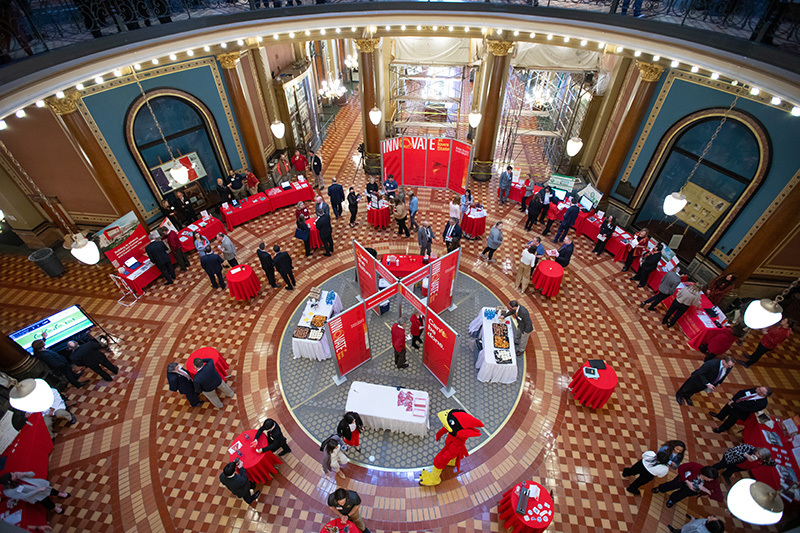
"Innovation for Iowa" was the theme for ISU's Day at the Capitol at the statehouse Tuesday. Photos by Christopher Gannon.
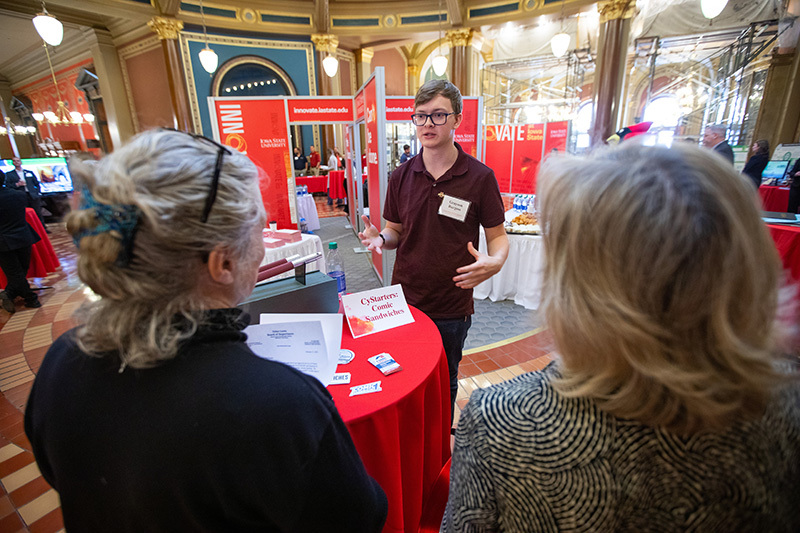
CyStarter student Grayson Burgess of Comic Sandwiches talks with visitors during ISU Day at the Capitol.
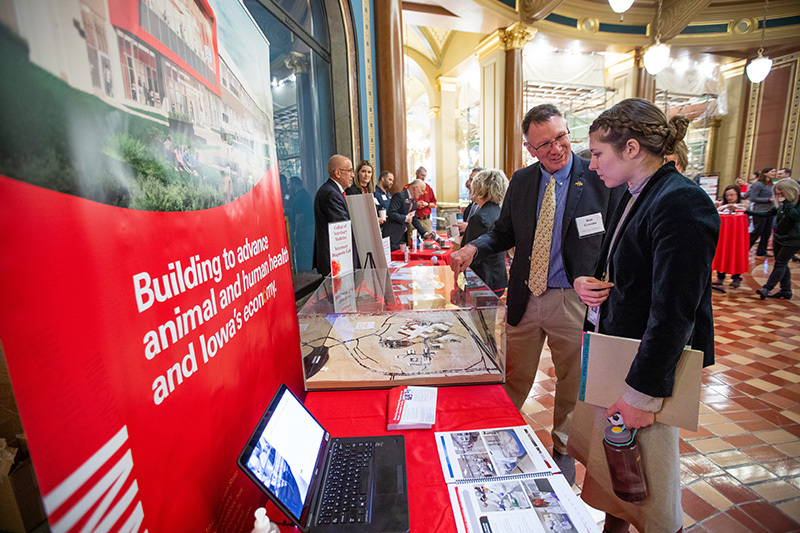
College of Veterinary Medicine dean Dan Grooms visits with Emma Schulte of the Legislative Services Agency at ISU Day at the Capitol. Nearly 50 faculty, staff and students and their Iowa-based partners participated in exhibits and talked with elected officials.
One-Act Play Festival highlights student directing, acting, design
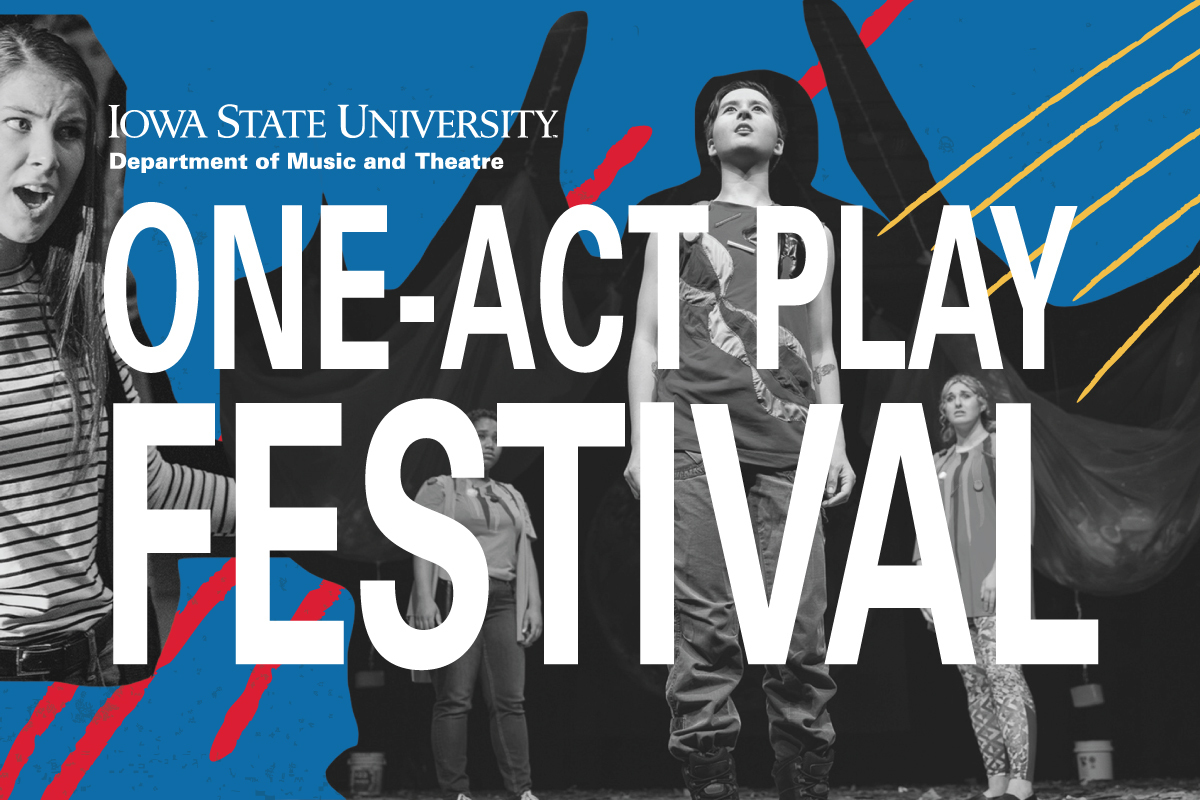
Expect an innovative and bold range of storytelling at ISU Theatre's One-Act Play Festival, opening March 3 in Fisher Theater. The nine plays in the festival include stories of a lovestruck alien, first dates, issues of race and policing, assassins and vampires, and pigeons in wartime.
It's the first time this student-produced festival will star in ISU Theatre's regular-season lineup. Students from advanced directing classes select, cast and direct the one-act plays, while students design all the sets, costumes and lighting.
A rotating selection of the plays, which contain adult content and language, will be performed each day of the festival, including two plays penned by performing arts senior Grant Tetmeyer.
"We're thrilled to bring these fresh perspectives and innovative talents to the Fisher Theater stage," said Brad Dell, chair of the music and theatre department. "I'm so excited for our students to share not only their amazing performances but to lead all creative aspects of the directing and design. Audiences are going to have fun."
Performances are March 3-5 at 7:30 p.m. and March 6 at 2 p.m. Each performance features a scheduled rotation of different festival selections. All seats are general admission and tickets ($20 for adults, free for students and youth) can be purchased at the door, through the Iowa State Center ticket office or Ticketmaster.
Individuals with disabilities who require an reasonable accommodation can contact ISU Theatre at least one week prior to the event at isutheatre@iastate.edu or 515-294-2624.
Creative collaboration
Kathryn Ripley, a senior in performing arts, is directing "Cuckoo Clock," a comedy about a first date gone wrong at a German restaurant.
"I read through so many one-acts, looking for the right one," she said. "As soon as I read 'Cuckoo Clock,' I knew that I had to direct it. It made me laugh so much, and I pictured myself having a ton of fun working on it and seeing it come to life."
As the director, Ripley is gaining new experience in creative collaboration.
"There are so many people working to get this play on its feet, and they bring so much to the table," she said. "The actors are so talented and funny, and they play the characters perfectly. With the collaboration from the actors, designers and stage management, I'm so excited to see our finished product. I hope audiences feel joy."
Heaven Booker, performing arts senior, chose to direct “Black Prometheus,” a powerful and mysterious dark comedy where two Black people are test subjects stuck in a negative-experience machine.
"I chose this play for a plethora of reasons," Booker said. "I loved all the aspects and topics this play touches on, such as police brutality, interracial relationships, prison reform and traveling internationally as a Black person. I will be challenged to tackle some of these topics with my cast in such a short time. I want them to understand the history, understand what they are saying and representing when they are onstage, and make sure the facts are correct and everyone is being represented accordingly."
Spotlight on student designers
For several of the student designers, this is their first time designing the lighting for a large-scale project in Fisher Theater.
"It'll be a learning curve that I'm incredibly excited for," said Bobbie Buie, performing arts sophomore and lighting designer for multiple plays. "Each show that I'm designing exists in a setting that is incredibly rich and different from our world, so I'm looking forward to crafting these interesting environments through lighting. I'm aiming for my design, along with scenic and costume design, to truly immerse the audience into these settings."
